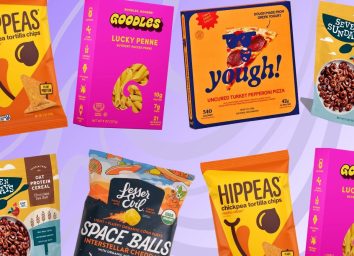
There are some food staples that rarely leave your grocery list. You have your go-to produce like apples and bananas. Then, there are the dairy essentials like milk and butter. And what would a trip to the supermarket be without snagging a good ol' loaf of bread?
Whether toasted with butter, sandwiching layers of meat and cheese, or served alongside a bowl of pasta, bread can be incorporated into just about any meal, making it a necessity for many. However, it can be hard to tell whether you're buying the highest quality loaf, especially if you don't know what to look for.
To help you choose the best bread, we consulted a few baking experts who offered some tips to consider the next time you peruse your grocery store's bread selection. Here's what they had to say.
Start by selecting the right store

Before you even get to the bread aisle, you should first consider the place where you are planning to shop. The quality of the supermarket itself can tell you a lot about the quality of its bread. Trung Vu, a pastry and baking arts chef-instructor at the Institute of Culinary Education (ICE), says he would "choose a grocery store with high foot traffic to ensure product is replaced often with fresh inventory." He also says to "consider the general cleanliness and sanitation of the store itself." A tidy store is a good indicator that products like bread are kept in good condition, too.
Look at the bread's plastic tag

If you're picking up a loaf of packaged bread, you might want to check more than just the "Sell By" or "Best By" date. "Bread purveyors and distributors will often also use a system of different colored twist ties corresponding to the day of the week it was delivered," Vu says.
According to EatingWell, the color of the bread's twist tie or plastic tag goes in alphabetical order, coinciding with the day of the week the loaf was baked. Many grocery stores will use the following code:
- Monday – Blue
- Tuesday – Green
- Thursday – Red
- Friday – White
- Saturday – Yellow
EatingWell adds that most bread bakeries will take a production break on Wednesday and Sunday.
While it's true that many bread producers follow a color-coding system with ties and tags, fact-checking website Snopes notes that the "Blue-Monday, Green-Tuesday" system isn't universal, meaning some suppliers may apply different meanings to their colors. The only way to know for sure, according to Snopes, is to contact the bread's manufacturer and ask about its color coding system (if it has one) and when it delivers to your store.
Even if you're unsure what the exact colors mean, inspecting the tags can still be useful. Snopes points out, "As it is, shoppers should never encounter more than two colors of tags on the shelf at any time for any one brand of bread: that of the most recent delivery and that of the one just before it."
Check the bread's ingredients

Beyond the bread's freshness, you'll want to look closely at what's in the product. For Amy Emberling, this means choosing bread with the shortest list of ingredients possible. "All you really need to make bread is water and flour. Salt is [a] helpful bonus," says Emberling, the managing partner and original baker of Ann Arbor, Mich.-based retail and wholesale bakery Zingerman's Bakehouse. "I'd want to avoid preservatives and additives that are used to extend shelf life."
Emberling is also partial to bread made with whole grains and without added sugar. "If there are two or more brands that meet my criteria, then I choose based on flavor and texture," she says.
Clemence Danko, founder and owner of New Jersey-based Choc O Pain French Bakery & Café, echoed a similar sentiment. "Most of the time, in all the bread that you have in the supermarket, there is sugar, very very very often. There is milk—there [are] things that maybe belong in a cake, but not in bread, at least not to the type of bread that I like," she says.
Emberling adds that a supermarket with its own on-site bakery usually offers a higher-quality product. "Often the in-store bakery has bread made from less refined ingredients and more natural ones, which is my preference," she says.
Take note of the crust

If you're selecting a loaf of bread from a bakery, which can include the one in your grocery store, looking at the crust is a crucial step. Danko says bread should have a hard crust, highlighting that she likes a thick crust that is "very dark, almost burnt," which is created through caramelization during the baking process.
Understand that not all breads are created equal

Size and shape are two factors that affect a bread's freshness, with Danko pointing out, "The bigger the bread, the longer it will stay fresh." Take a baguette, for example, which is long and thin. This type of bread will stay fresh for a day or two, while Danko says something like a French miche, which is a big and round loaf of bread made with a sourdough starter, will last around four or five days.
To maximize the freshness of your bread, many experts recommend freezing it. The freezer can be a better option than the fridge, as Vu notes that refrigeration can hasten bread going stale. The chef-instructor says you can tightly wrap uncut bread in plastic wrap and keep it frozen until ready to consume.
"Bread will thaw at room temperature within 1-2 hours and can be dampened with a clean moist towel or water from a spray bottle and reheated in a 350 [degree] oven for about 10 minutes or until heated through to the center," Vu says. "It will be very close to as good as fresh baked bread!"









